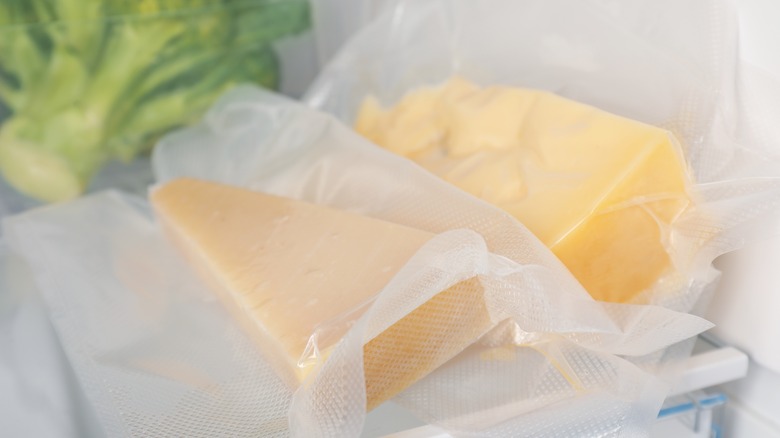The Worst Part Of Your Fridge For Storing Cheese
In general, cheeses should always be stored in the refrigerator to prevent foodborne illnesses and to protect the food's quality. That being said, you shouldn't keep your cheese just anywhere in the fridge. Shelves in the door, for instance, are subjected to changing temperatures every time you open the appliance, which makes them not stable enough, temperature-wise, to store dairy.
On a similar note, you shouldn't keep your cheese in the coldest part of your fridge, either, which is usually in the back and at the bottom. When cheese gets too cold, it can become dry and crumbly, or even rubbery in texture, which is not ideal.
Instead, store cheeses where the temperature is most stable — in a vegetable crisper drawer. Not only do these drawers maintain a fairly consistent temperature, but they also provide the humidity necessary to keep cheese fresh and moist. A specific cheese drawer can also be used, but be sure to monitor the humidity in the space, as too much moisture can encourage bacterial growth.
Be careful about storing your cheese in the freezer too
As mentioned previously, cheese should not be stored in the coldest part of your fridge, so for this reason nor should it be stored in the freezer — if you want to come off as a cheese-serving expert. Too cold temperatures can cause the cheese to crumble and lose its taste and no one wants that.
To be clear, however, none of this is to say you can't freeze cheese; you just need to be mindful of how you go about it. For instance, you should avoid freezing softer cheeses, as these have higher moisture contents (and therefore are more susceptible to drying out and crumbling). Harder cheeses, especially those used for melting purposes, will hold up better to freezing and any change in texture will be lost when melted, anyway.
Regardless of the type of cheese, you shouldn't store any in the freezer for longer than nine months. Generally speaking, the quality will decline more the longer it's frozen, and its texture will never be quite the same as it was before freezing.
How to package cheese for the longest shelf-life
No matter how you choose to prepare your cheese for refrigeration or freezing, the goal always remains the same: Ensure there's as little contact with air as possible, especially to minimize freezer burn. As such, the easiest way to store cheese is in its original, unopened packaging. You might also store unopened dairy in additional bags, parchment paper, or aluminum foil to further mitigate freezer burn or texture changes.
If you have an open package of cheese, your best bet is to vacuum seal it in a fresh bag. But, if you don't have a vacuum sealer laying around, you can also properly seal frozen food without one by placing it in a freezer bag and pressing out all the air. Alternatively, you can wrap blocks of cheese in parchment paper, followed by aluminum foil. While not ideal for long-term storage, this method provides a reasonable amount of protection against moisture and the cold.



